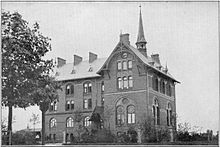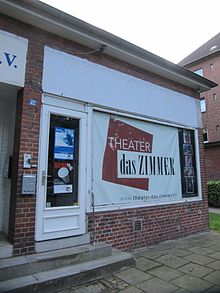Hamburg Horn
|
Horn district of Hamburg |
|
|---|---|
| Coordinates | 53 ° 33 '15 " N , 10 ° 5' 24" E |
| surface | 5.8 km² |
| Residents | 38,373 (Dec. 31, 2019) |
| Population density | 6616 inhabitants / km² |
| Post Code | 22111, 22113, 22119 |
| prefix | 040 |
| district | Hamburg-Mitte district |
| Transport links | |
| Highway |
|
| Federal road |
|
| Subway |
|
| Source: Statistical Office for Hamburg and Schleswig-Holstein | |
Horn ( Low German : Hoorn ) is a district in the Hamburg-Mitte district of the Free and Hanseatic City of Hamburg .
geography
Geographical location
Horn lies partly in the glacial valley of the Elbe . The border between the Geest in the north and the fertile marshland in the south runs through the district.
Expansion of the urban area
Horn is limited to the south by the Bille . In the north, the federal motorway 24 to Berlin forms the district boundary , in the west the Hamburg freight bypass line . In the east, Legienstrasse is the border to the Billstedt district ; this is where the Hamburg state border was until the Greater Hamburg Act came into force in 1938.
Neighboring districts
Bordered to the north Marienthal to Horn in the east Billstedt , south Bill Brook and West Hamm .
history
The name Horn means projection , here a wooded ridge that stood out from the flat marshland of the Hammerbrooker meadows. Horn was first mentioned in a document in 1306 when the knight Heinrich von Wedel transferred a court in Horn to the Hospital of the Holy Spirit . At that time the village was located around today's Bauerberg road . In 1383 Count Adolf VII. Von Holstein-Kiel sold the place to the Hamburg council , which in 1410 incorporated it into the newly formed lordship of Hamm and Horn . Since the beginning of the 17th century, Hamburg merchants have been building country houses with extensive gardens in Horn. The place gradually lost its village character and became a place of residence for wealthy Hamburg residents.
The French occupiers of Hamburg planned to burn Horn down in 1814 (like Hamm before) as a field of fire against the advancing Russian troops, but because of the rapid Russian success, this no longer came about, so that the place was saved. Through the reorganization of the Hamburg area, Horn came to rule the Geestland in 1830 . Shortly afterwards, in 1833, the Lutheran pastor Johann Hinrich Wichern , who was a supporter of the pietistic awakening movement, founded the Rauhe Haus on the border with Hamm in a thatched roof provided by Karl Sieveking as a rescue house for big city children . Today, the foundation of the same name takes on many of the Diakonie tasks in Hamburg. The Horner racecourse was built in 1855 and the gallop derby (initially North German Derby , now German Derby ) has been held here since 1869 . In 1874 Horn was elevated to a suburb of Hamburg, and incorporated into it in 1894.
In the 1920s and 1930s, Horn was settled on a large scale and built with multi-storey apartments in the typical Hamburg brick style. The planning of the National Socialist transport policy envisaged building a motorway yard in Horn as the eastern entrance to the city and the end point of the Reichsautobahn coming from Berlin . Only the Horner roundabout was implemented , the planned imposing development did not materialize. In the Second World War Horn was largely destroyed and the reconstruction lasted until the 1960s. In 2006 Horn celebrated its 700th anniversary with a large district festival , at which the musician Guildo Horn also performed.
Religions
Like the entire city area, Horn also became Evangelical Lutheran with the introduction of the Reformation in the 16th century . However, the place only got its own church in 1886 with the Martin's Chapel. In 1894 the church was given a bell tower and thus became Martinskirche, before Horn was parish in Hamm. After the Second World War, other Lutheran churches were built with the Timotheus Church, the Nathanel Church, the Capernaum Church and the Philip Church. The Kapernaumkirche was deedicated in 2004 and stood empty for several years. It is currently being converted into a mosque . There is also a Roman Catholic Church, the St. Olaf Community, and a Free Evangelical Community in Horn.
From 1888 to 1997, Hamburg-Horn was the location of the seminary of the German Baptists . The teaching building and the student dormitory were located at Rennbahnstrasse 115. The Baptist theological training center relocated to Wustermark-Elstal near Berlin in the course of German reunification . With the seminar, the Central Oncken Archive of the Federation of Evangelical Free Churches also moved there.
population
The population of Hamburg-Horn is made up as follows (data from the North Statistics Office, as of December 2016):
- Total population: 38,549 people
- Minor quota: 15.4%, is below the Hamburg average of 16.2%.
- Share of households with children: 15.8%, below the Hamburg average of 17.8%.
- Elderly rate (65-year-olds and older): 15.8%, below the Hamburg average of 18.3%.
- Proportion of foreigners: 25.2%, is well above the Hamburg average of 16.7%.
- Share of benefit recipients according to SGBII (Hartz IV): 17.1%, is well above the Hamburg average of 10.3%
- Unemployment rate: 7.2%, is above the Hamburg average of 5.3%.
Hamburg-Horn is one of the poorer districts of Hamburg. The average annual income per taxpayer was around 21,685 euros in 2013 and is significantly lower than the Hamburg average (39,054 euros).
Population development
- 1988: 37.216
- 1990: 38.502
- 1992: 39.237
- 1994: 38,597
- 1996: 37.817
- 1998: 36,402
- 2000: 35,522
- 2002: 35,350
- 2004: 36.291
- 2006: 36,490
- 2008: 37,351
- 2010: 37,635
- 2012: 37,599
- 2013: 37,614
politics
For the election to the citizenry , Hamburg-Horn belongs to the constituency of Hamburg-Mitte . The 2020 citizenship election led to the following result in the district:
- SPD : 40.9% (- 8.7 percentage points)
- CDU : 10.1% (- 4.7% points)
- Left : 13.9% (+ 3.1% -points)
- AfD : 10.0% (+ 0.2% pts.)
- Greens : 19.2% (+ 10.1 percentage points)
- FDP : 3.7% (+ 0.2% -points)
- PIRATES : 2.2% (- 0.3% -points)
Culture and sights
theatre
- With the " Theater das Zimmer ", which has around 40 seats, is Hamburg's smallest theater in Horn.
- Since 2006, the " Small Court Theater ", originally founded in the Wandsbeker Bürgerhaus, has been using the community hall of Martinskirche as a new venue and in 2010 celebrated its 25th anniversary there.
Buildings
The Martinskirche from 1886 has been a listed building since 1998 (architect: Johannes Vollmer ). An example of typical church construction after the Second World War is the Kapernaumkirche , which was built by Otto Kindt in 1960/61 and was used as a church until 2004 . The Beim Pachthof school, built by Fritz Schumacher from 1929 to 1931, is also typical of its time .
Art in public space

In the Hamburg-Horn district there is a large number of art objects in public spaces. Some of the abstract or figurative art objects can be attributed to an artist on the basis of an engraving or plaque, others are unmarked.
Parks
- Blohms Park
- Horner Park
- Horner Moor - a small park with a pond that was formerly a natural swimming pool. In the southern part there is a large playground and a bicycle training area. The Speckenreye school is also adjacent to this park.
- Horner Rennbahn - outside the racing season (late June to early July), the Horner Rennbahn amusement park is freely accessible. Inside there is a skate field, basketball court, mini golf course , three barbecue areas, green areas and a fenced dog run area and a lake.
- From Dratelnscher Park
Sports
The German Derby has been held every July on the Hamburg-Horn racecourse since 1869 . The current buildings date from 1911, but have been rebuilt and changed several times. The German Versatility Derby also took place here in 2001, 2003 and 2004 .
The largest club in the district is the Hamburg-Horner Turnverein from 1905 , which temporarily entered into a cooperation with SV St. Georg in football under the name FC St. Georg on Horner TV . This cooperation was dissolved in 2007 and Horner TV is again playing independently in football. The association also has the departments of gymnastics, badminton, dancing and table tennis.
Economy and Infrastructure
Established businesses
The ThyssenKrupp escalators GmbH is the largest with 750 employees, employers in the district.
traffic
The federal autobahn 24 (coming from Berlin) ends at the Horner roundabout , which also marks the north-west corner of the district. Bundesstrasse 5 runs to the south of the district . Both are connected by Ring 2 , the middle Hamburg street ring .
The Hamburg-Horn depot is on the Hamburg freight bypass .
The metro has stops with Horner racecourse and Legienstraße two breakpoints of U2 ( Niendorf Nord - Mümmelmannsberg ) and U4 ( Billstedt - HafenCity University ) in the district. The Horner Rennbahn station is also a hub for bus traffic.
education
- Protestant College for Social Work & Diakonie des Rauhen Haus
- Evangelical college for elderly care
- District school Horn, consisting of the three locations, Rhiemsweg 6, Snitgerreihe 2 and Horner Weg 89
- Brothers Grimm district school, consisting of the two locations Steinadlerweg and Querkamp
- Evangelical Wichern school with elementary school, district school and grammar school
- Elementary School Horn
- Speckenreye primary school
- Elementary school at the Pachthof
- Elementary school Sterntalerstraße
See also
- List of streets, squares and bridges in Hamburg-Horn
- List of cultural monuments in Hamburg-Horn
- List of stumbling blocks in Hamburg-Horn
Web links
Individual evidence
- ^ Statistics Office North, Hamburg District Profiles, reporting year 2016, pages 38–39; Data status December 31, 2016 (accessed February 9, 2018)
- ↑ Statistics Office North: Regional results-historical time series ( Memento of the original from June 17, 2008 in the Internet Archive ) Info: The archive link was inserted automatically and has not yet been checked. Please check the original and archive link according to the instructions and then remove this notice.
- ↑ North Statistics Office: District Profiles 2013
- ↑ North Statistics Office: Hamburg District Profiles 2014
- ↑ Citizenship election 2020. Retrieved on August 3, 2020 .












